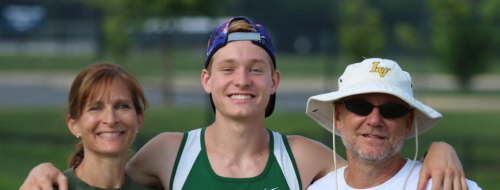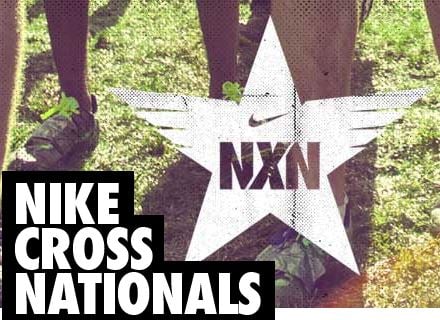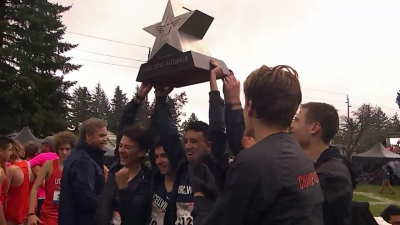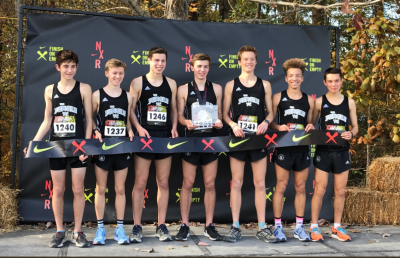Q&A, Part I: Marc & Joan Hunter, Coaches Of Back-To-Back NXN Champions Loudoun Valley, Discuss Their Training Philosophy & How To Build A Champion
By Jonathan Gault
December 5, 2018
Last week, Loudoun Valley (Va.) High School, competing as “Purcellville,” won its second straight boys’ championship at Nike Cross Nationals. The win was historic for two reasons; not only did it represent the first repeat victory by a boys’ school in the 15-year history of NXN, but, for the second year in a row, Loudoun Valley set the meet record for lowest score, tallying just 77 points.
The masterminds behind Loudoun Valley’s success are married couple Marc and Joan Hunter, who took over a struggling program in the fall of 2014 when their son, Drew, was a junior on the team. The success of Drew — who won the 2015 Foot Locker national title and ran 3:57 for the mile as a high schooler — helped draw attention (and bodies) to the program, and even after Drew graduated in 2016, the program continued to improve, culminating with back-to-back national titles. Another son, Jacob, was a member of both of those teams.
Both Marc and Joan are accomplished runners in their own right. Marc owns a 13:36 5,000 pb and was fourth at the 1977 NCAA XC meet for Cleveland State, while Joan has won masters national titles in the 400 and 800.
On Monday night, LetsRun.com spoke with both Marc and Joan Hunter for almost an hour in a phone interview. We’ve broken the interview into two parts. In part I, we talked about the team’s success at NXN, how they built Loudoun Valley into a powerhouse, and their training philosophy. In part II, which will be published on Thursday, we spoke about supplemental work and what the team does to improve outside of running and why Loudoun Valley has so many transfers on its team (three of its top five at NXN this year were transfers).
 The Hunters with Drew in the middle (courtesy Joan Hunter)
The Hunters with Drew in the middle (courtesy Joan Hunter)
First of all, congrats to both of you guys. Obviously a huge accomplishment, what you’ve done the last two years. And I guess I’ll start there: how do you win two straight NXN boys’ titles? It’s never been done before.
Marc: Well, we’ve never done it before, so this is a first for anyone. We had a lot of pieces fall into place for us. And I think I’ve learned after two years that if you’re one of the top teams and you don’t completely blow up, you have a really good chance of winning the meet because both years, we had several things not go well for us and yet our boys were able to work their way through those things and come out on top. And I know other teams, unfortunately, had some issues both last year and this year. And I think we just, for some reason, our boys were just able to overcome any issues.
Anything to add on that, Joan?
Joan: Not really. I think that that about covers it. I don’t think we really even had a fabulous day. There’s really no way you could say we had a great day as a team, and yet we had fewer issues than other teams did.
Marc: Are you familiar with the Tully guy, the rankings (Bill Meylan, who runs the terrific Tully Runners website analyzing high school cross country performances)?
Yeah.
Marc: He said something, I think he said it last year and he said it this year, that no one ever runs their best at nationals. And oh my gosh, that is very, very prophetic. I think he’s on to something, because we didn’t run our best either year. Other teams didn’t either. And we just happened to put a few good performances together with some mediocre performances and we were able to overcome running on fumes, as every team is at the end of the season, and overcoming travel, overcoming sickness, illness, injury, all those things like all the other teams have had happen to them, and just come out on top.
That said though, you guys set the record for lowest score at NXN in the meet’s 15-year history. Is that kind of crazy for you guys to think that you’re saying you didn’t have your best day, but that’s the best day any boys’ team has ever had at that meet?
Joan: Yeah, I think that just shows, I guess, that a lot of teams each year — I mean, I know there have been other great teams out there and it’s just — I don’t know. Yeah. I was pretty surprised we scored as few points as we did.
Marc: The boys were interested in beating last year’s record. We had a meeting the Monday before we got on the airplane on Wednesday. So what I do is I tell each kid where he should be in the pack, okay, and I say we’ll shoot for that. I give him a window of about 10 places. And I say, this is all designed for you guys to score in the low 80s, okay? And they buy into that. But it didn’t come to fruition. It didn’t work out. Some kids performed poorly and didn’t meet the place goal and others exceeded it. The bottom line is, really no other team performed well enough to beat us. Like I said, I was stunned at the end. When I heard 77, I just couldn’t believe it. (Editor’s note: Marc had seen a two-mile split that mistakenly listed LV in third due to a chip error)
Obviously a lot of things go into building a national champion. But if you guys had to say, what is the most important key to your team’s success over the last two years?
Joan: Well that’s a tough one. I think the fact that they are really bought into what they’re doing, they love what they’re doing, they’re very bonded, they’re very team-oriented. That’s a lot more than one thing. You just asked us the main thing and that was a few things, but I’m not sure you could say there’s any one thing.
Marc: Well I think one thing is they’re good athletes. They’re good runners. And sometimes, it’s a coach’s job not to screw it up. And I think maybe that’s where we were. Just don’t muck it up. Just get ’em fit, get ’em confident, let ’em know they’re good, and just open the gate and let ’em race.
Yeah, because obviously you can’t win a national title without some talent. I’m wondering, if you had to assign a percentage, how much of your team’s success is due just to the talent of the guys who you have on the roster?
Joan: That’s a hard one.
Marc: I would say if we trained these guys differently and did different training and experimented and did some other training techniques, I would say that they would have been top five. But I think we train them to peak at the national championships. They’re talented athletes and we think we know what we’re doing as coaches to prepare them. We’re not perfect, we know, and every kid is different. We try to train to the kids’ strengths and weaknesses and all that.
I’d probably give it a 70% [innate athletic ability] and 30% [coaching] if you had to nail it down.
Joan: Obviously the kids have some talent and ability. But I would not say that, by any stretch, that all of them were showing signs of being superstars or anything like that. But they all have basic ability and we’ve developed them pretty consistently. And then, obviously, we all know, everyone loves to accuse us of recruiting all our transfers, which we have never done. But some of our transfer kids obviously have ability too. We’re trying to get them to another level. But we’ve also worked on the kids on our team that are homegrown and have some ability but maybe not that superstar level, and they’re just running really well, consistent training over time.
When I ran in high school, I cared a lot about the sport, but it was very hard to get other people on the team to buy in. How did you guys build a winning culture of success at Loudoun Valley?
Marc: I think we got real lucky. We had two things going for us the first year we coached. We had a superstar — that was Drew, our son — and then we had a really good freshman class of kids that bought into the culture that we expected and that we thought would be a winning formula. They bought into it. And that just builds on itself. They want to be part of something special and unique, I think, high school kids, looking for something different. We have a lot of kids that have tried other sports, youth sports, growing up, and they’re either burned out or they were mediocre or they just didn’t quite fit in. Cross country, at least on our team, is a very welcoming group of kids. And so you had that combination. We had a superstar that everyone thought was just a normal kid, we had that really good group of freshmen, and I think our team was very welcoming. And I think that’s the reason.
How many kids did you have on your roster this year?
Marc: 120.
And that’s 120 boys, or is that boys and girls combined?
Marc: That’s boys and girls combined.
What is the gender breakdown?
Marc: It’s always about 55/45, boys to girls. It seems like every year it’s the same percentage, a few more boys than girls.
How many kids tried out at the start of the season?
Marc: Well we don’t cut. Last year, we had, before the season started, I had 178 kids on the roster. And I said, we cannot. There’s no way we can handle 178, so I petitioned the county for extra coaches. But if we got extra coaches, then every other team in the county, even those with 20 on their roster, would have to have another coach. So they said no. So, knowing full well that I didn’t have the heart to cut anyone, I just sent out an email to parents saying, we’ve gotta do something about the roster size, I might have to cut kids. And the next day, 30 kids didn’t show up to practice. So last year, I think we ended up the season at 128. Thirty kids kind of cut themselves and a few others [left] by the end of the first week, so we were down to a manageable level.
Is it the most popular sport in the school?
Marc: It is. We’re 10% of the school. Ten percent of the school runs cross country, which is pretty cool. We’re bigger than the football team, the kids who try out for basketball. Yeah. We’re definitely bigger than the band. I don’t think any other sport comes close.
Once you guys get that culture going, how difficult is it to maintain it?
Joan: It hasn’t been, really.
Marc: We’re in our fifth year, and every single year until this year, when it stabilized, the team has grown in size and the results have gotten better. And I’m talking about results down to the JV team. We stress a lot on our team how well the JV teams do at meets. We want to win the JV races. That’s really important to us. That’s really important to how to develop that winning culture. We like them to walk away with medals around their necks and trophies in their hands and to know that, gosh, I’m the 40th guy on the team and yet I was just part of a winning effort at my level. That excites kids and then they look, they think, I want to be on the junior-senior JV team and try to win a medal there. And obviously, like any good coach, we stress improvement. And those kids, they’re fired up. They really want to improve and I think starting at such a low level and stressing team victory has been a boon for us.
Joan: I also think, kind of to piggyback off that, we really make a pretty big deal of writing the training for every kid on the team. So the slowest kid on our team gets their own personal training paces in workouts and attention paid to details for their training. Obviously a new kid that’s never done a sport before isn’t going to be doing the same training as a kid two years older who’s been with the program for two years. And I think that’s something that a lot of high school programs, especially programs with lots of kids, do not do. It’s kind of like everything is focused on the top kids and sort of survival of the fittest, do the best you can if you’re one of the other kids on the team. We just don’t do that. I try to make all of the athletes feel like their performances matter.
Do you guys have jobs outside of coaching? What do you guys do for a living?
Joan: I just stay home and write training plans all day.
Marc: She’s the stay-at-home mom — we have nine kids. I work for an agency called the National Geospatial-Intelligence Agency. I can’t tell you what my job entails, but I work 55 miles away from home so that’s kind of a drag. I have to get up early in the morning so I can get home in time for practice. But that’s what I do. Neither of us teach in the school system.
Obviously those are two things that take a decent amount of time. That’s not a short commute, and raising nine kids, I’m sure that takes a lot of time and a lot of moving pieces, that sort of thing. How do you guys find the time to do all that and coach at such a high level?
Marc: Well we have to do it because we enjoy coaching so much and we love our kids. We just make it work. We sacrifice a lot of things, like vacations. Every once in a while, we get to go on a family vacation. But a lot of our kids are older now and out of the house which gives us a little more time. And our kids run, too. They’re on the team so we get to spend time with them in that way and at those times. But we just make it work. It’s our passion and we enjoy it. I have to work because I have to pay the bills and I like to eat and I like a warm bed to sleep in. So I have to work; if I didn’t have to work, I’d probably coach even more kids.
Joan: Because I don’t have a job, I can spend part of the day — I usually spend kind of a lot of the day — working on running-related things. I don’t want to do this and do it poorly. It takes a lot of time to do it well, at least for me. I’m sure there are some coaches out there who are wizards at it and can get things set up quickly and get everything done, but I tend to take a lot of time thinking about my training and figuring out what I want to do and moving things around. It does take a lot of time.
I’ve read in interviews, Joan, you’re the one who is doing the X’s and O’s implementation of the training and that sort of things. And I know Tinman (Tom Schwartz, who coaches Drew, among others, and heads up the professional training group Tinman Elite) has an influence on that, at least your philosophy, that sort of thing. So I’m wondering, what is your training philosophy, and how much of it was influenced by Tinman and what you learned from him?
Joan: Well Tinman influenced me a lot because he coached me as a masters runner about 10 years ago. Just briefly, I had heard about him, I think I probably read about him on LetsRun and I started [visiting] his messageboard and just reading a lot of stuff that I was intrigued by because I was running masters stuff. And I started training using a lot of his principles and it was very different than what I liked to do or what I had really done in the past. And I started really improving, enough that I decided to hire him to coach me for a season or two. I didn’t hire him for a really long time. I just didn’t want to have to think about my own training. Sometimes that’s just a really nice thing, to not have to think about it.
And I really did well under him. And honestly, from 400 meters to 5k, I was running masters PRs. So I was really sold on this. And then Marc and I started coaching youth somewhere in that range, or we had been coaching youth. I’m trying to remember. About the same time, I guess, we started our youth team when I was first fooling around with Tom’s training. And we started using it with our kids at a reduced level and just really found a lot of success with our younger runners doing the kinds of things that Tom recommended. So that was the influence that he had on me, was really just having success myself and then with our youth team.
So when we took over the high school program, I pretty much knew what I would be doing with the kids if we were going to coach the high school team. I’d say our training has evolved. I’ve added certain things in. Tom’s training for me was very individualized, kind of a one-on-one thing, so implementing on it for a team, there were some different things that I do. I have other things that I do that are not things he does. But it all works together and fits together. I think it stays pretty true to his principles. He always likes to “keep the ball rolling,” which means find that level of training that you can maintain consistently pretty much year-round. And I think that’s [a] huge key piece to successful training for anybody. Not getting hurt, not getting sick all the time, not getting burned out, not physically feeling exhausted. And that’s really what we do. Our team does not do workouts as hard as a lot of other teams, probably any other teams, I’d be willing to bet. We just keep certain elements in our training and make sure they’re there all the time and don’t overdo the hard training.
How fast are they going in their fastest workouts?
Joan: Everyone loves to hear about our standard workout of critical velocity-type reps (for a full explanation of critical velocity, click here). So for instance, a kid like Sam Affolder or Jacob Hunter, low-15:00 guys for 5k, they’re running their critical velocity reps, say on a grassy course with hills, at 3:06 [for one kilometer] probably. So slower than 5k race pace, easily. And we really just don’t do a lot of hard, sustained efforts. We do tempo runs and those are probably on the slower end of tempo pace for kids for most teams. Everything is just controlled. We don’t really do any VO2 max work at all during the season. Maybe at the very end of season, we would start doing a straight set of CV reps at CV pace, [then] we would do some cutdowns so there might be a couple of reps that are at like VO2 max pace. But we would never do sustained hard, hard, hard sets of faster stuff.
We do shorter, quicker stuff at the end of our stamina workouts. So we might run 7 x 1000m and then do 5 x 200m hills or something like that, faster.
And the critical velocity stuff, are you doing a critical velocity workout once a week? How often do you hit that pace in workouts?
Joan: Mostly once a week, not always. It really depends on what we’ve got going on race-wise, sometimes weather-wise. It just will really depend. Instead of a critical velocity day, we might run threshold miles or something like that instead. But there will always be at least one workout — if it’s a race week, there will only be one workout — based on stamina paces between critical velocity and tempo pace. There will be something, either 1000s or, like I said, threshold miles or a sustained tempo run. But if it’s a race week, there will only be one workout.
What sort of mileage are your top runners hitting?
Joan: Peak mileage was around 70 for a couple of kids on the team. I would say we were consistently between 60 and 65 for most kids. We have one boy on our varsity who was running probably less than 40.
Who was that?
Joan: Carlos Shultz. He is our kid that moved here this summer and just comes from a very, very low mileage background.
More: Part II Here: Q&A, Part II: Marc & Joan Hunter Explain Loudoun Valley’s Supplemental Work & Respond To Claims That They Recruit Transfers
Talk about this interview on our world famous fan forum / messagebhoard: MB: How to win NXN two years in a row? Joan and Marc Hunter Q & A
Did you know, you can go a high school only messageboard here?
This interview has been condensed for clarity.


